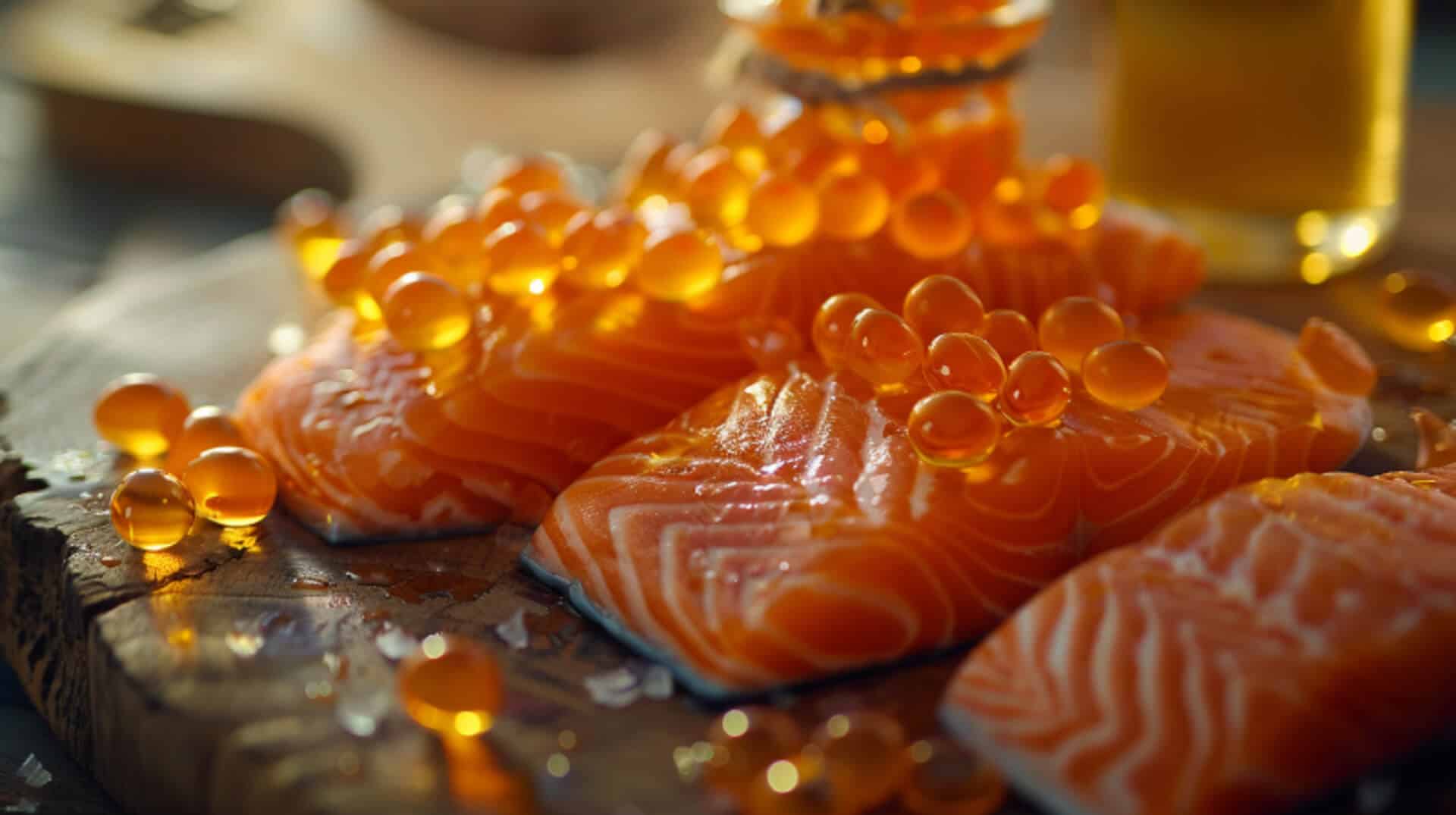Vital Roles of Vitamin A in Human Health
Vitamin A, a fat-soluble nutrient, is pivotal for maintaining vision, bolstering the immune system, and ensuring proper organ function. It plays an indispensable role in the production of rhodopsin, a protein in the eyes that absorbs light in the retinal receptors, aiding in low-light vision and colour vision. Moreover, it is crucial for the differentiation and functioning of white blood cells, which are integral to the immune defence mechanism.
Impact on Vision and Immune System
Vitamin A’s contribution to ocular health extends beyond vision clarity; it is essential for the preservation of the cornea and conjunctival membranes. In the realm of immunity, it fortifies the body’s barriers against infection, such as the mucous membranes in the eyes and respiratory tract, enhancing the body’s ability to combat pathogens.
Role in Reproduction and Organ Health
Retinol, the active form of Vitamin A, is vital for reproductive processes and embryonic development. It supports the proper functioning of the heart, lungs, kidneys, and other organs, maintaining their structural integrity and physiological operations.
Essential for Skin Health and Cell Growth
Vitamin A’s role in skin health is attributed to its involvement in cell production and growth. It aids in the formation of skin and mucous membranes, keeping them healthy and robust against external threats. The nutrient also stimulates fibroblaststhe cells responsible for developing tissue that keeps skin firm and healthy.
Storage and Utilisation of Vitamin A
The liver acts as the primary storage site for Vitamin A, releasing it into the bloodstream as needed, ensuring a consistent supply for the body’s requirements. Dietary sources of Vitamin A include two types: preformed Vitamin A (found in animal products like fish, meat, and dairy) and provitamin A carotenoids (present in fruits and vegetables). The body efficiently converts these compounds into retinol, which is then utilised for various physiological functions.
Distinction Between Retinol and Carotenoids

Retinol, the active form of vitamin A, is found in animal sources such as fish, while carotenoids, which are precursors to vitamin A, are abundant in plant sources. Your body utilises retinol directly, but it must convert carotenoids like beta-carotene into retinol before they can be used.
Conversion of Carotenoids to Active Vitamin A
The conversion of carotenoids to active vitamin A is influenced by several factors, including the food matrix, the amount of dietary fat present, and individual absorption efficiency. Carotenoids are best absorbed when consumed with fats due to their fat-soluble nature.
Genetic Variations and Vitamin A Processing
Genetic variations can significantly affect how efficiently your body converts carotenoids to retinol. Some individuals may have genetic mutations that reduce the efficacy of this conversion, impacting their vitamin A processing and potentially altering their dietary needs for this nutrient.
Essential Factors for Vitamin A Absorption

To ensure effective absorption of vitamin A, your diet must include an adequate amount of dietary fats. Vitamin A is a fat-soluble vitamin, meaning it requires the presence of fat for proper absorption in the gastrointestinal tract.
Role of Dietary Fats in Vitamin A Bioavailability
Dietary fats play a crucial role in the bioavailability of vitamin A. They facilitate the solubilization and absorption of this nutrient by forming micelles, which are absorbed by the intestinal mucosa. Including healthy fats in your meal can significantly enhance the uptake of vitamin A from fish sources.
Long-Term Health Implications
The fat-soluble nature of vitamin A implies that it can be stored in the body, primarily in the liver, for long-term use. This storage capability underscores the importance of maintaining a balanced intake to prevent both deficiency and potential toxicity.
Maximising Vitamin A Absorption from Fish
To optimise the absorption of vitamin A from fish, it is recommended to consume fish with a source of dietary fats. This could include drizzling olive oil over cooked fish or pairing it with other foods high in healthy fats, such as avocados or nuts. Cooking methods that preserve the integrity of vitamin A, such as baking or steaming, are also advisable.
High Vitamin A Fish Varieties

When seeking dietary sources of vitamin A, certain fish species stand out for their rich content. Cod liver oil, a potent fish-derived supplement, is renowned for its high vitamin A levels, providing a substantial amount in each serving. This oil, extracted from the liver of codfish, not only offers vitamin A but also contains omega-3 fatty acids, contributing to heart and brain health.
Fish Liver Oils and Vitamin A Intake
Fish liver oils, such as cod liver oil, are not only a concentrated source of vitamin A but also serve as an excellent supplement for those looking to boost their intake. These oils are often consumed in capsule form or as a liquid, making them a convenient addition to your diet.
Nutritional Benefits of Mackerel, Salmon, and Tuna
Incorporating fish like mackerel, salmon, and tuna into your diet can provide numerous health benefits. These fish are not only valuable for their vitamin A content but also for their omega-3 fatty acids, which are essential for maintaining cardiovascular health and cognitive function.
Comparing Vitamin A in Fish to Other Animal Sources
Fish are a commendable source of vitamin A, often surpassing the levels found in other animal products. For instance, a single serving of cooked salmon can deliver a significant portion of the recommended daily intake for vitamin A, making it an excellent choice for those looking to enhance their nutrient consumption.
Recommended Dietary Allowance for Vitamin A

The Recommended Dietary Allowance (RDA) for vitamin A varies by age, gender, and life stage. Adults require different amounts:
- Men: 900 micrograms of Retinol Activity Equivalents (RAE) per day
- Women: 700 micrograms of RAE per day
Meeting Vitamin A Needs Through Fish
Fish consumption is an effective way to meet these vitamin A requirements. For example, a 3-ounce serving of cooked salmon can provide up to 50% of the RDA for women and about 25% for men.
Risks of Inadequate Vitamin A Intake
Not meeting the RDA for vitamin A can lead to deficiency, with symptoms including night blindness and an increased risk of infections. In children, it can cause growth retardation and increase mortality risk.
Balancing Vitamin A Intake
To avoid toxicity, it’s crucial to balance vitamin A intake. Consuming a variety of fish species can help mitigate the risk of excess intake, especially those with lower mercury content. Monitoring consumption and considering both dietary and supplemental sources of vitamin A will ensure a balanced intake.
Optimal Cooking Methods for Vitamin A Preservation

To maximise the retention of vitamin A in fish, certain cooking methods are more favourable than others. Steaming and baking are recommended as they are less likely to degrade the vitamin A content compared to high-temperature methods like frying.
Cooking Practices Impacting Nutrient Value
Excessive heat and prolonged cooking times can reduce the nutrient value of fish. To preserve vitamin A, it is advisable to avoid overcooking and to use gentle cooking methods that maintain the integrity of the fish’s natural oils.
Freshness and Vitamin A Potency
The freshness of fish is directly correlated with its vitamin A potency. Freshly caught or properly frozen fish retains more vitamin A compared to fish that has been stored for extended periods.
Simple Recipes for Vitamin A-Rich Fish
Incorporating vitamin A-rich fish into one’s diet can be achieved through simple recipes that emphasise the natural flavours and nutritional benefits of the fish. For instance, a baked salmon with a drizzle of olive oil and a sprinkle of herbs not only enhances taste but also ensures the preservation of vitamin A.
Recognising Vitamin A Deficiency and Toxicity

Vitamin A deficiency and toxicity are two extremes that you should be aware of when managing your nutritional intake. Recognising the signs and symptoms is crucial for maintaining optimal health.
Symptoms of Vitamin A Deficiency
Deficiency in vitamin A can manifest in several ways, including:
- Night Blindness: Difficulty seeing in low light or darkness, one of the earliest signs.
- Dry Eyes: Lack of adequate tears, which can lead to more serious eye conditions.
- Skin Issues: Dry, itchy, or bumpy skin, often a result of changes in keratin levels.
- Increased Infection Risk: A weakened immune system leading to frequent infections.
Symptoms of Vitamin A Toxicity
Excessive intake of vitamin A, particularly from supplements, can lead to toxicity, with symptoms such as:
- Headaches and Dizziness: Caused by increased pressure within the brain.
- Nausea and Vomiting: Often accompanied by abdominal pain.
- Blurry Vision: Due to changes in the pressure around the optic nerve.
- Skin Changes: Peeling or itchy skin, a common sign of overdose.
Role of Fish in Vitamin A Balance
Fish, especially those high in vitamin A like salmon and mackerel, play a significant role in preventing both deficiency and excess. They provide a natural source of vitamin A that is less likely to cause toxicity compared to high-dose supplements.
Monitoring Vitamin A Intake
To monitor and adjust vitamin A intake:
- Track Dietary Sources: Keep a food diary to record your intake from both food and supplements.
- Consult Nutritional Labels: Be mindful of the vitamin A content in fortified foods and supplements.
- Seek Professional Advice: If you’re unsure about your vitamin A status, consult a healthcare provider for personalised guidance.
Importance of Sustainable Fishing for Vitamin A Sources

Sustainable fishing practices are essential to maintain the populations of fish that are rich in vitamin A, such as salmon, mackerel, and tuna. These practices help ensure that fish stocks are not depleted and that the marine ecosystem remains balanced, supporting the long-term availability of these vital nutritional resources.
Frozen Fish Direct’s Commitment to Sustainability
Frozen Fish Direct takes pride in offering vitamin A-rich fish products that are sourced through environmentally responsible methods. They prioritise suppliers who adhere to sustainable fishing practices, ensuring that the fish you consume is not only nutritious but also ethically obtained.
Certifications Indicating Sustainable Practices
Certifications such as the Marine Stewardship Council (MSC) and Aquaculture Stewardship Council (ASC) are indicators of sustainable fishing practices. These certifications assure consumers that the fish they purchase comes from sources that prioritise the health of marine life and habitats.
Making Informed Choices as a Consumer
As a consumer, you can make informed choices about sustainably sourced fish by:
- Looking for Certifications: Check for sustainability labels on product packaging.
- Researching Brands: Choose brands like Frozen Fish Direct that are transparent about their sourcing.
- Asking Questions: Inquire about the origin of fish when shopping or dining out.
- Supporting Responsible Fisheries: Opt for fish from fisheries that engage in practices aimed at preserving marine ecosystems.
Ecological Considerations for Vitamin A-Rich Fish

When selecting fish for their vitamin A content, ecological considerations are paramount. Overfishing poses a significant threat to the sustainability of fish populations, particularly those species known for their high vitamin A levels, such as tuna, mackerel, and salmon.
Impact of Overfishing on Nutrient Availability
Overfishing can lead to a decline in the availability of vitamin A-rich fish species, disrupting not only the marine ecosystem but also human nutrition. It is essential to manage fish stocks responsibly to ensure a continuous supply of these nutrient-dense foods.
Consumer Influence on Sustainable Fishing
Consumers have the power to drive change towards environmentally responsible fishing practices. By choosing to purchase fish from sustainable sources, you’re supporting fisheries that prioritise the health of marine ecosystems and the longevity of fish populations.
Frozen Fish Direct’s Approach to Environmental Concerns
Frozen Fish Direct addresses environmental concerns by sourcing their products from suppliers who adhere to sustainable fishing methods. This commitment ensures that the fish you consume is not only rich in essential nutrients like vitamin A but also harvested in a way that supports the preservation of marine life and habitats.
Integrating Fish into a Nutritious Diet

Incorporating fish into a balanced diet offers a multitude of health benefits beyond vitamin A. Fish is a lean protein source, rich in omega-3 fatty acids, which are crucial for cardiovascular and cognitive health.
Nutritional Profile of Fish
Fish provides a diverse array of nutrients, including:
- Omega-3 Fatty Acids: Essential for heart and brain function.
- Protein: Vital for muscle building and repair.
- Vitamins: Such as D and B2, in addition to vitamin A.
- Minerals: Including iodine, selenium, and zinc.
Balancing Vitamin A Intake
To balance vitamin A intake:
- Diversify Your Diet: Include both animal and plant sources of vitamin A.
- Monitor Portion Sizes: Ensure fish consumption aligns with dietary guidelines.
- Consider Dietary Restrictions: Adjust fish intake based on individual health needs.
Dietary Guidelines for Fish Consumption
General dietary guidelines recommend:
- Eating Fish Twice a Week: Opt for a variety of species to obtain different nutrients.
- Safe Cooking Practices: Cook fish to the proper internal temperature to ensure safety.
- Sustainability: Choose fish from sustainable sources to support environmental health.
Accessing High-Quality Vitamin A-Rich Fish

Access to high-quality fish, a key source of vitamin A, can be hindered by factors such as geographic location, seasonal availability, and economic constraints. Frozen Fish Direct addresses these barriers by providing a reliable supply of frozen fish, ensuring that nutrient-rich options are available year-round, regardless of local market limitations.
Frozen Fish Direct’s Role in Quality Assurance
Frozen Fish Direct ensures quality by:
- Sourcing from Trusted Suppliers: They partner with fisheries that adhere to sustainable practices and quality checks.
- Maintaining Cold Chain Integrity: Their products are frozen at sea to preserve freshness and nutrient content, including vitamin A levels.
Consumer Guidelines for Purchasing Fish
When purchasing fish, consumers should:
- Check for Freshness: Look for clear eyes and firm flesh in fresh fish, or ensure that frozen fish is well-packaged with no signs of freezer burn.
- Verify Source: Choose products with clear labelling about the source and sustainability certifications.
Options for Those Without Access to Fresh Fish
For individuals without access to fresh fish, alternatives include:
- Canned Fish: A convenient and often more affordable source of vitamin A.
- Fish Oil Supplements: While the benefits are debated, they can be a supplementary source of vitamin A for those with dietary restrictions.
Key Takeaways on Vitamin A and Fish

Understanding the sources and benefits of vitamin A in fish is essential for maintaining good health. Fish such as salmon, mackerel, and tuna are not only rich in omega-3 fatty acids but are also excellent sources of vitamin A, which is vital for vision, immune function, and skin health.
Ensuring Consistent Vitamin A Intake
To ensure a consistent intake of vitamin A through fish consumption, consider the following:
- Diversify Your Fish Choices: Include a variety of fish in your diet to benefit from different levels of vitamin A and other nutrients.
- Check for Freshness: Opt for fresh or properly frozen fish to maximise vitamin A content.
Tips for Selecting Vitamin A-Rich Fish
When selecting fish for vitamin A content, keep these tips in mind:
- Sustainability Matters: Choose fish from sustainable sources to support environmental health.
- Cooking is Key: Use methods like steaming or baking to preserve vitamin A during cooking.
Frozen Fish Direct’s Role in Optimal Health Benefits
Frozen Fish Direct can assist in providing quality fish by:
- Offering a Wide Selection: A variety of fish options ensures a rich intake of vitamin A.
- Ensuring Quality: Their commitment to freshness and nutrient retention maximises the health benefits of their fish.








